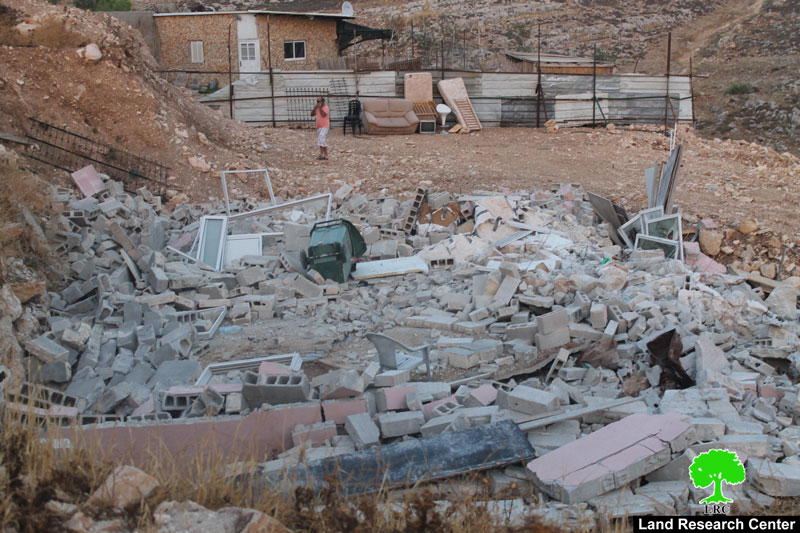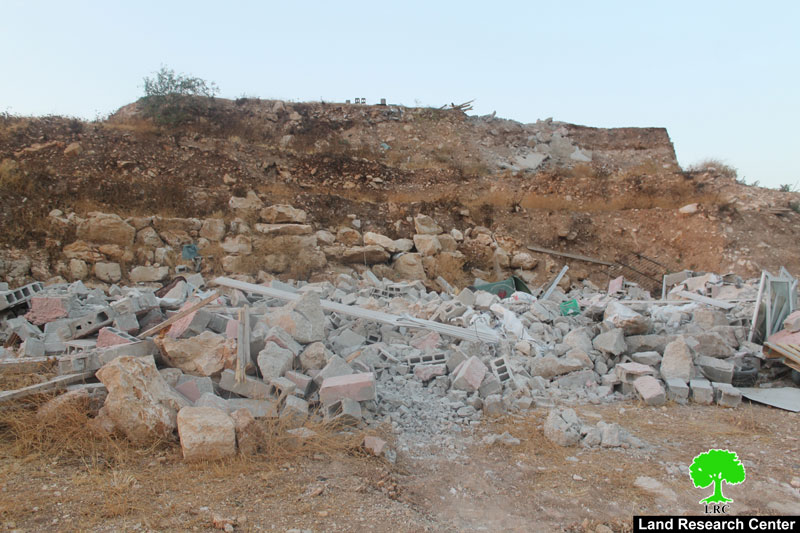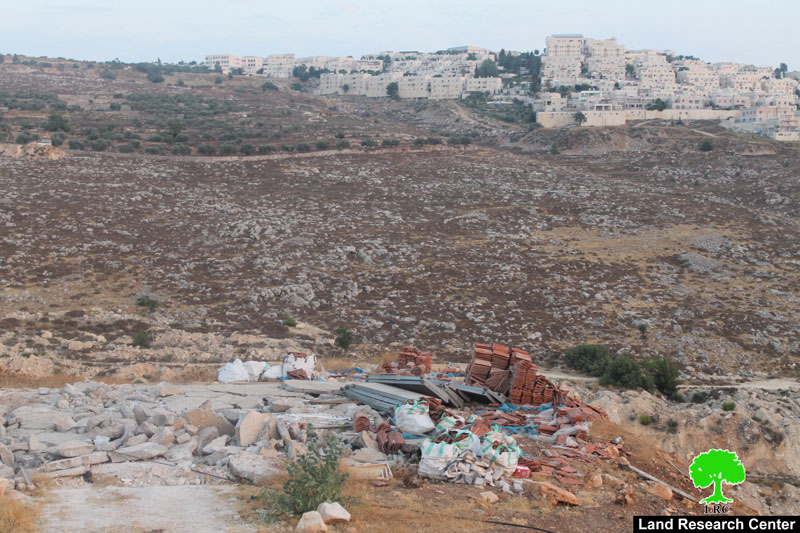2017-07-04
هدم مسكنين وسور وتجريف قطعة أرض مجهزة بالاسمنت في حي الاشقرية ببيت حنينا / القدس المحتلة
في الرابع من تموز 2017م أقدمت جرافة تابعة للاحتلال بهدم مسكنين سكنيين في حي الأشقرية في بيت حنينا بحجة البناء بدون ترخيص. كمان قامت بهدم سور إستنادي كان حول المسكنين، إضافة لذلك قامت بتجريف قطعة أرض بمساحة 110 متر مربع مجهزة بالإسمنت.وتعود ملكية المسكنين المهدومين للمواطنين:
# | الإسم | مساحة المسكن م2 | عدد الأفراد | أطفال | حالة المسكن |
1 | خالد علي درويش ربايعة | 185 | 7 | 3 | جاهز للسكن |
2 | محمد خالد علي ربايعة | 110 | 3 | 1 | مستخدم للسكن |
وأفاد المواطن خالد ربايعة لباحث مركز أبحاث الأراضي:
تم بناء المسكن في عام 2015 بمساحة 185م2 مكون من 3 غرف نوم وصالة ومطبخ وحمامين، وهو مبني من الطوب والإسمنت، وكان من المفروض أن أنتقل للسكن فيه بعد اسبوع من تاريخ الهدم. وانا لم اتقدم للبلدية من أجل إستصدار رخصة بناء لأن الأرض التي عليها البناء هي غير منظمة بحسب مخططات البلدية. كما قمت ببناء سور من الطوب حول المسكن على طول 150 متر وبإرتفاع 2 متر، وقمت بتجهيز قطعة أرض مساحته 110 م2 بالإسمنت من أجل بناء مخزن عليها.
وأفاد المواطن محمد خالد ربايعة لباحث مركز أبحاث الأراضي :
قمت ببناء المسكن قبل عام بمساحة 110م2 مكون من غرفتين وصالة وحمام ومطبخ، وقد سكنت فيه لمدة 6 أشهر مع زوجتي وطفلتي، وقد بلغت تكلفة بناء المسكن 350 ألف شيقل، وفي يوم الثلاثاء الموافق 4 تموز 2017 ، حضرت قوات كبيرة من شرطة الاحتلال برفقة جرافة وقاموا بإغلاق المنطقة بشكل كامل، ثم قام أفراد من الشرطة بإخراجنا من المسكن وقاموا بإخراج بعض الأثاث الذي كان داخل المنزل قبل أن تقوم جرافة الاحتلال بهدم المسكن بشكل كامل.
يضيف المواطن خالد ربايعة :
لقد تفاجأنا بالجرافة التي حضرت لهدم مسكني ومسكن ولدي محمد، لأننا لم نتسلم من اي جهة قرار هدم أو إنذار، أو وقف بناء، فالهدم كان بشكل مفاجئ دون سابق إنذار. وقد استمر الهدم لمدة ساعتين (من الساعة التاسعة صباحاً لغاية الساعة الحادية عشر قبل الظهر)، ثم قامت الجرافة بهدم السور الذي يحيط بالمسكن ويبلغ طوله 150م، كما قامت بهدم قطعة الأرض المجهزة بالباطون بمساحة 110م2.


مساكن عائلة ربايعة وقد تحولت إلى ركام بعد أن هدمتها بلدية الاحتلال في حي الاشقرية ببيت حنينا
يذكر أن الموقع الذي جرى فيه هدم المسكنين لا يبعد سوى 300م هوائي عن مستوطنة "رامات شلومو" المقامة على أراضي بلدة شعفاط، حيث تطل بشكل مباشر على الموقع، ويعد السبب لمنع بلدية الاحتلال من البناء في المكان هو قرب الموقع من المستوطنة وأن هنالك نية لشق شارع بين المستوطنة والمساكن ليكون حد فاصل بين المستوطنة والمنطقة، لذلك لا تسمح البلدية بأي عملية بناء بالمكان، كما أنها تقوم بتنفيذ عمليات الهدم بحق المواطنين الذين يقومون ببناء مساكنهم هناك.
 ركام مساكن عائلة ربايعة وفي الخلف مستعمرة "رمات شلومو" المقامة على أراضي بيت حنينا
ركام مساكن عائلة ربايعة وفي الخلف مستعمرة "رمات شلومو" المقامة على أراضي بيت حنينا

مستعمرة "رامات شلومو" تشهد توسعاً كبيراً
تعقيب قانوني:
إن ماتقوم به سلطات الاحتلال من عمليات هدم للمساكن والمنشآت الفلسطينية يأتي ضمن انتهاكاتها للقانون الدولي والإنساني، وانتهاك حق من حقوق المواطنين الفلسطينيين الذي كفله القانون الدولي والمعاهدات الدولية وهو الحق في سكن ملائم، ضمن المواد التالية:
المادة 147 من اتفاقية جنيف الرابعة والتي تنص على أن 'تدمير واغتصاب الممتلكات على نحو لا تبرره ضرورات حربية وعلى نطاق كبير بطريقة غير مشروعة وتعسفية.' تعتبر مخالفات جسيمة للاتفاقية .'.
المادة 53 من اتفاقية جنيف الرابعة لعام 1948 تحرم تدمير الممتلكات، حيث تنص هذه المادة على ما يلي: 'يحظر على دولة الاحتلال أن تدمر أي ممتلكات خاصة ثابتة أو منقولة تتعلق بأفراد أو جماعات، أو بالدولة أو السلطات العامة، أو المنظمات الاجتماعية أو التعاونية، إلا إذا كانت العمليات الحربية تقتضي حتماً هذا التدمير.
المادة 33 من اتفاقية جنيف الرابعة تنص على أنه : 'لا يجوز معاقبة أي شخص محمي عن مخالفة لم يقترفها هو شخصياً.
كما حذرت الفقرة 'ز' من المادة 23 من اتفاقية لاهاي لعام 1907م من تدمير " ممتلكات العدو أو حجزها، إلا إذا كانت ضرورات الحرب تقتضي حتما هذا التدمير أو الحجز.
المادة 17 من الإعلان العالمي لحقوق الإنسان، المؤرخ في 10 كانون الأول 1948 تنص على انه " لا يجوز تجريد أحد من ملكه تعسفا ".
هذه الحالة جزء من أنشطة مشروع كنعان

